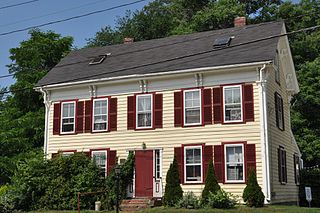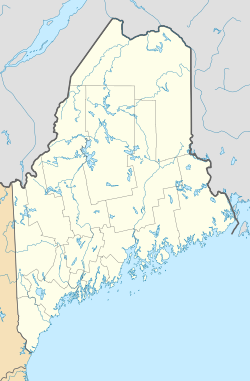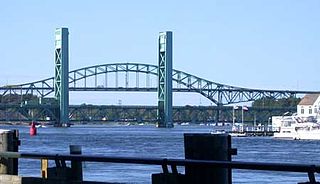
Portsmouth is an independent city in the Commonwealth of Virginia. As of the 2010 census, the population was 95,535. It is part of the Hampton Roads metropolitan area.

Kittery Point is a census-designated place (CDP) in the town of Kittery, York County, Maine, United States. First settled in 1623, Kittery Point traces its history to the first seafarers who colonized the shore of what became Massachusetts Bay Colony and later the State of Maine. Located beside the Atlantic Ocean, it is home to Fort McClary State Historic Site, and Fort Foster Park on Gerrish Island. Cutts Island is home to Seapoint Beach and the Brave Boat Harbor Division of the Rachel Carson National Wildlife Refuge.
USS Captor (PYc-40), briefly the seventh ship to bear the name USS Eagle (AM-132), was a Q-ship of the United States Navy.

The Norfolk Naval Shipyard, often called the Norfolk Navy Yard and abbreviated as NNSY, is a U.S. Navy facility in Portsmouth, Virginia, for building, remodeling, and repairing the Navy's ships. It is the oldest and largest industrial facility that belongs to the U.S. Navy as well as the most multifaceted. Located on the Elizabeth River, the yard is just a short distance upriver from its mouth at Hampton Roads.

USS Grayling (SSN-646), a Sturgeon-class attack submarine, was the fifth ship of the United States Navy to be named for the grayling. Her keel was laid down in 1964, and she was launched just over three years later, and commissioned in 1969. She was involved in the submarine incident off Kola Peninsula on 20 March 1993, when she collided with the Russian Navy submarine Novomoskovsk. She was decommissioned in 1997, and disposed of a year later.

USS New Hampshire (SSN-778), a Virginia-class nuclear-powered attack submarine, is the fourth vessel of the United States Navy to be named for the state of New Hampshire. She is the first of the Virginia Block II submarines to enter service. Her name was awarded to the submarine after a letter-writing campaign by the third-graders from Garrison Elementary School and sixth graders from Dover Middle School in Dover to their members of Congress, the state governor, and the Secretary of the Navy.

Portsmouth Naval Prison is a former U.S. Navy and Marine Corps prison on the grounds of the Portsmouth Naval Shipyard (PNS) in Kittery, Maine. The building has the appearance of a castle. The reinforced concrete naval prison was occupied from 1908 until 1974.

Seavey's Island, site of the Portsmouth Naval Shipyard, is located in the Piscataqua River in Kittery, Maine, opposite Portsmouth, New Hampshire. It encompasses 278 acres (1.13 km2).

The First Congregational Church and Parsonage is a historic church complex at 23 Pepperrell Road in the Kittery Point section of Kittery, Maine. Built in 1730 for a congregation first organized in 1653, the church is the oldest in Kittery, and one of the oldest in the state of Maine. It is accompanied by a parsonage house, built in 1729, and a small cemetery, established in 1733. The buildings were listed on the National Register of Historic Places in 1978; the cemetery was added to the listing in 1997.

Badger's Island is located in the Piscataqua River at Kittery, Maine, directly opposite Portsmouth, New Hampshire. It carries U.S. Route 1 between the states, connecting to the Kittery mainland by the Badger's Island Bridge, and to New Hampshire by the Memorial Bridge. Now largely a suburb of Portsmouth, the island features houses, condominiums, restaurants and marinas.

William Badger was a master shipbuilder operating in Kittery, Maine, United States who built more than 100 vessels.

Fort Foster, now part of Fort Foster Park, is a historic fort active 1901-1946 on the southwest tip of Gerrish Island in the Kittery Point area of Kittery, Maine. The park includes beaches and trails. Battery Bohlen and Battery Chapin were the major parts of the fort.

The Rice Public Library is the public library of Kittery, Maine. It is located at 8 Wentworth Street in the central Kittery Foreside village, in an architecturally distinguished Romanesque Revival building built in 1889 and listed on the National Register of Historic Places in 1979, with a large annex just across the street at 2 Walker Street.

The Mark F. and Eliza J. Wentworth House is a historic house at 9 Wentworth Street in Kittery, Maine. Probably built in the second quarter of the 19th century and given Italianate styling c. 1866, it is notable for its association with Mark Fernald Wentworth, a distinguished physician and decorated veteran of the American Civil War. The house was listed on the National Register of Historic Places in 1998.

The Portsmouth Downtown Historic District encompasses the historic urban core of Portsmouth, New Hampshire. With a history dating to the 17th century, Portsmouth was New Hampshire's principal seaport and the center of its economy for many decades, and the architecture of its urban center is reflective of nearly four centuries of history. The district is roughly L-shaped, radiating from the downtown Market Square area to South Street in the south and Madison and Columbia streets in the west, with more than 1,200 historically significant buildings. It was listed on the National Register of Historic Places in 2017. The district includes 35 previous listings on the National Register, and five National Historic Landmarks.
























